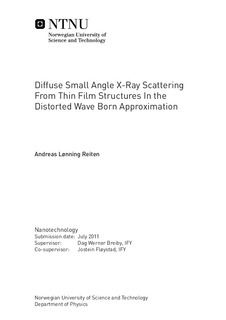Diffuse Small Angle X-Ray Scattering From Thin Film Structures In the Distorted Wave Born Approximation
Master thesis
Permanent lenke
http://hdl.handle.net/11250/246492Utgivelsesdato
2011Metadata
Vis full innførselSamlinger
- Institutt for fysikk [2695]
Sammendrag
The differential scattering cross section for diffuse scattering of X-rays from thinfilm structures is discussed within the framework of the distorted wave Born ap-proximation (DWBA). In contrast to the standard Born approximation (BA), thedistorted wave approach succeeds in calculating scattering from surfaces near thecritical angle of reflection. The method is particularly useful for studying averagesurface properties.Compromises made in the derivation of the model substantially simplify thefinal expression, but also limit its range of validity, which depends on the surfaceroot mean square roughness σ and the momentum transfer between the incidentand scattered X-rays perpendicular to the surface, Qz . The approximation is validso long as (Qz x σ) << 1.However, this is also the only regime where it is necessary togo beyond the simpler Born approximation.A computer simulation software based on the DWBA is implemented in Python.The implemented DWBA depends on the fractal dimension of the surface featuresthrough a parameter h (D = 3 − h) and an in-plane correlation cut off length ζ.The various effects of changing key model parameters, among them ζ and h, isdemonstrated. Comparison between experimental data and the DWBA modellooks promising although there are some challenges in relation to determiningthe fractal dimension.Finally, the feasibility of implementing the DWBA model in a multi-parameterfitting algorithm is discussed.
